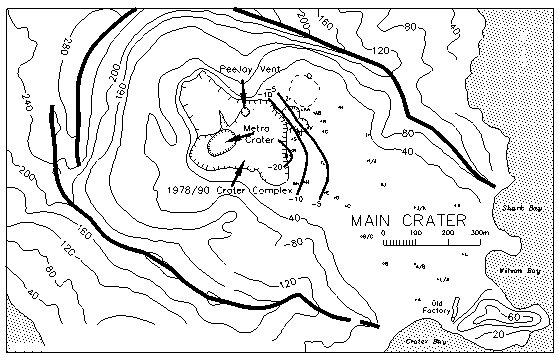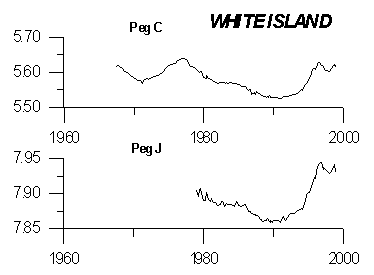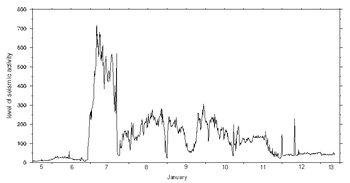
Science Alert Bulletin WI-1999/03 - White Island Volcano
13 January 1999, 4:00 pm - Update
Summary
Eruptive activity is continuing at White Island. A multiple vent-crater (Metra) has formed on the floor of 1978/90 Crater, but has now stopped erupting. The active vent (PeeJay), which formed in August 1998, continues to emit dense volcanic gas and steam with some volcanic ash. Volcanic tremor levels have declined, but remain slightly above typical background levels for White Island.
A surveillance visit was made on Tuesday 12 January to assess the ongoing activity, conduct a deformation survey, collect ash and gas samples and service the seismic installation. The results available to date from that visit are reported below.
In summary, minor eruptive activity continues at White Island. The level of eruptive activity has varied with time, being higher following the formation of the new vent last week. The current level of eruptive activity and volcanic indicators confirm an Alert Level of 2. We anticipate the current style of eruptive activity may continue for some time and will vary in intensity with time.
Observations
Only one vent was active during our visit, this being PeeJay vent at the base of the north-west wall of 1978/90 Crater (Fig. 1). The vent size has not changed appreciably since November 1998. During this visit the vent was emitting under high pressure considerable volcanic gas and steam, and carried only a minor amount of dark grey volcanic ash. The plume rose to about 300 - 350m before trailing off down wind for 10 - 15km. The volume of ash contained in the plume was less than observed over the past month. Measurements near Peg Z, some 140m east-north-east of PeeJay Vent, show that about 120 mm of fine ashes have accumulated in this area between 1 December 1998 and 12 January 1999, in at least 12 episodes of ash fall, presumably mainly from PeeJay Vent. Near Peg M, some 280m south-east of PeeJay Vent, only half that thickness was recorded.
A considerable portion of the floor of 1978/90 Crater has collapsed forming a multiple vent – collapse crater feature, named Metra Crater (Fig. 1). The margins of this feature are characterised by scalloped areas which have subsided 5 - 10m. On the north side very fresh ground cracks are present, and more collapse is likely in this area. During our visit, Metra Crater was essentially inactive, with vivid white steam being emitted from numerous vents. The deeper vents in Metra (15 - 20m deep) contain pools of muddy dark grey water, and are likely to be the site of previously observed hydrothermal eruptions. Eruptions occurring in Metra Crater over the period from when it was first seen on 7 January through 11 January have produced a surrounding apron of closely spaced ballistic blocks on the 1978/90 Crater Complex floor. Scattered impact craters containing blocks up to 40cm occur on the 1978/90 Crater Complex rim in areas frequented by visitors, and isolated impacts were noted up to 350m from Metra Crater near Noisy Nellie.
The ground deformation survey shows a consistent trend of minor deflation across the main crater floor, with continued subsidence near the rim of 1978/90 Crater, (Fig. 1). Shown in Figure 2 are time series plots for two selected marks, showing the large scale inflation post 1990 and minor deflation over the last 2 - 3 months.
As shown in the Fig. 3, volcanic tremor levels have declined following the high which accompanied the formation of Metra Crater last week. Volcanic tremor levels do remain slightly higher than those measured before the formation of the new vents.
Discharge temperatures and characteristics for fumaroles on the main crater floor were little changed from the previous visit on December 1. Fumarole #1 measured 111°C, but Ti tubes removed from the vent were coated in molten sulphur, indicating temperatures in the conduit of at least 119°C. Elemental sulphur continues to accumulate near this and neighboring vents on the southern crater wall at high rates, suggesting that sulphur is being remobilised at depth. Discharges on Donald Mound and Gully were very weak, reduced to steaming ground. Noisy Nellie and #13a discharge pressures were strong, with temperatures of 134°C and 115°C respectively.
Alert Status
Eruptive activity is now continuous at White Island and we advise the Volcanic Alert Level remains at Level 2. Based on the past eruptions and the data available to date we expect the current style of eruptive activity may continue for some time. The size of the eruptions wiill vary in intensity with time. Explosive eruptions producing ballistic ejecta are possible, particularly if Metra Crater reactivates.
Brad Scott
Volcano Surveillance Manager






